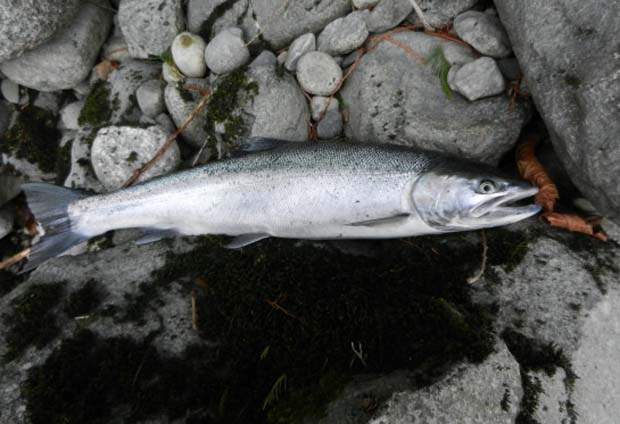[dropcap]W[/dropcap]ild Fish Conservancy and the Washington Department of Fish and Wildlife (WDFW) have settled the lawsuit filed by the Conservancy March 31, 2014 seeking Endangered Species Act (ESA) compliance for WDFW’s “Chambers Creek” hatchery winter steelhead programs. Since the first listing of Puget Sound salmon under the ESA in 1999, almost all of WDFW’s hatchery programs in the region have continued to produce and release hatchery salmonids without the evaluation and legal permission required under the ESA. Under the settlement, WDFW will cease planting Chambers Creek hatchery steelhead in all Puget Sound rivers but one, until NOAA approves each specific hatchery program. The settlement also establishes a twelve-year moratorium of such hatchery plants in the Skagit River system, Puget Sound’s largest tributary and most important wild steelhead river.
“This agreement is a giant win for Puget Sound’s wild steelhead and their recovery,” said Kurt Beardslee, executive director of Wild Fish Conservancy.
Contrary to popular belief, the Chambers Creek hatchery programs, like many hatchery programs, do not aid wild fish recovery. Recent scientific evidence indicates that this hatchery-origin steelhead adversely affects wild steelhead by causing negative genetic, ecological, and demographic effects. In 2010, scientists from the regional science center of the NOAA Fisheries Service concluded “Chambers Creek steelhead have no role in the recovery of native Puget Sound steelhead.” WDFW is required to develop “hatchery genetic management plans” for each hatchery which must then be reviewed and approved by NOAA to ensure that the proposed programs do not significantly impede the recovery of ESA-listed salmon and steelhead. The vast majority of WDFW salmon and steelhead hatcheries have been operating without this approval for more then ten years.
Taxpayers are supporting and funding many important efforts across the region to restore wild salmon and steelhead, but tax dollars are also supporting some state hatchery programs that are working at cross purposes and impeding recovery. WDFW’s data show that the cost to produce a single harvested Skagit River Chambers Creek hatchery steelhead ranged from $160 to $940 in the years from 2001-2012. “Our hope is that the funds supporting these programs will be redirected to more effective, long-term, and sustainable solutions like habitat restoration and preservation,” says Beardslee.
In 1969, the steelhead was declared Washington’s official “state fish.” Despite that recognition, wild Puget Sound steelhead populations have steadily declined. Since being listed as threatened under the ESA in 2007, the five-year average of Puget Sound wild steelhead abundance is about 25% of what it was in 2004, and less than 3% of what it was in 1900. NOAA recently rated twelve of twenty Puget Sound populations as having a “high” risk of extinction.
“There are four major causes for the decline of salmon and steelhead,” Beardslee continued. “Loss of habitat is the largest problem facing salmon and steelhead recovery. The public has invested hundreds of millions of dollars in habitat restoration and preservation and we need to continue this important work. But science clearly points to dams, hatcheries, and over-harvest as three additional problems that need to be fixed. Applying science-based hatchery practices is something we can do right now that will have immediate and long-term positive benefits. Fisheries all over the world have collapsed because politics, not science, guided their management. Science remains the best and most reliable compass to guide recovery and to meet our solemn stewardship responsibility to future generations.”
The combination of the Puget Sound and Skagit moratoriums is the largest and most significant effort of its kind on the West Coast. The moratorium will help protect Puget Sound’s wild steelhead populations from the negative impacts of the Chambers Creek hatchery programs and will also provide the opportunity to establish the Skagit River system as the largest wild steelhead research project of its kind. The information gained from such a project will help guide and inform future salmon and steelhead recovery efforts.
“This magnificent fish is an icon of our Northwest culture and lifestyle,” Beardslee concluded. “Wild steelhead fed indigenous people for thousands of years and now it is also the sportsman’s most prized fish. Today’s agreement will help recover wild steelhead so they can again support sustainable fisheries in the future.”
The unpermitted Chambers Creek steelhead hatchery programs in Puget Sound were the sole subject of the suit, filed in the US District Court for western Washington in Seattle. The group is represented by Smith and Lowney, PLLC, of Seattle.
[information]
WILD FISH CONSERVANCY
PO Box 402 Duvall, WA 98019
Tel 425-788-1167 • Fax 425-788-9634
info@wildfishconservancy.org
Contact: Kurt Beardslee, Wild Fish Conservancy, 425-788-1167
Brian Knutsen, Smith and Lowney, PLLC, 971-373-8692
[/information]








